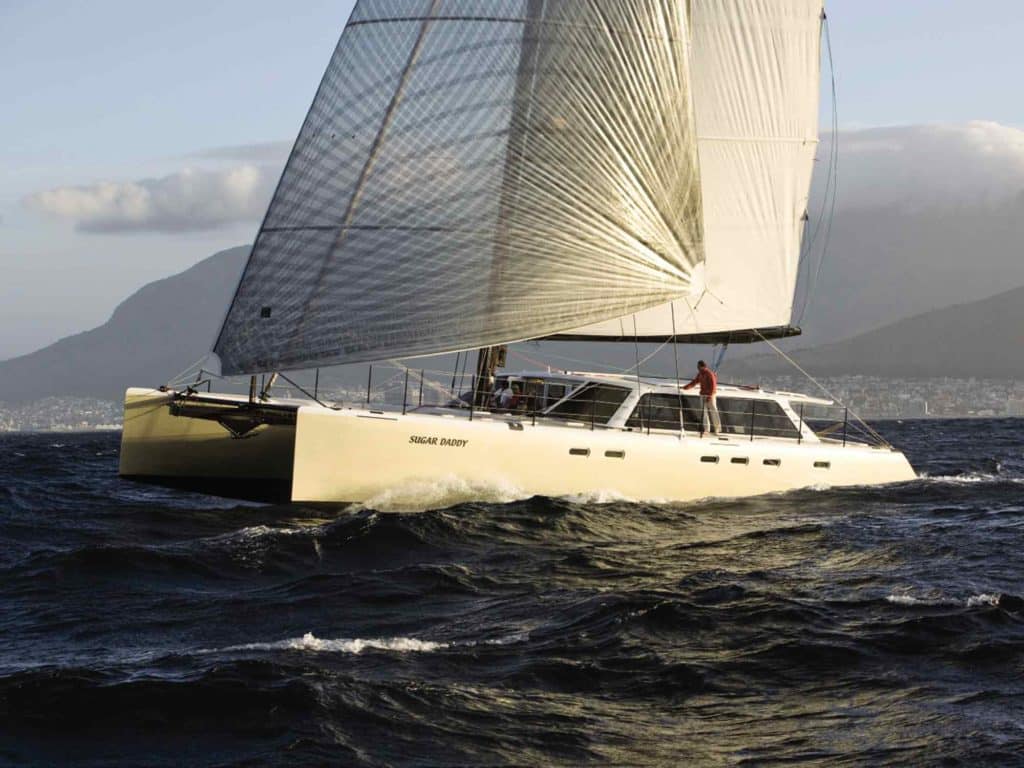
My first real taste of the rarefied world of contemporary performance-cruising catamarans was precisely 15 years ago, midway through the 40th-anniversary edition of Antigua Sailing Week, aboard the Gunboat 62 Looking for Elvis. It was a surreal, memorable experience on several fronts, not the least of which is that the big, rangy cat’s owner—a Las Vegas guy called Bruce Slayden—had emerged from his quarters that morning decked out in full Elvis Presley regalia, right down to the tight jumpsuit and fake sideburns.
But the real revelation came on the last race of the day, when Slayden’s pro skipper asked me, “You want the helm for this one?”
I’d driven big cats before, including British legend Robin Knox-Johnston’s 60-footer, British Airways, on a trans-Atlantic voyage, so I understood the basics: Fast catamarans manufacture their own apparent wind, which is constantly trending forward, which means you are always bearing away in the puffs; and your trusted best friend is the mainsail trimmer, permanently poised to blow the mainsheet and/or traveler if things get squirrelly (that is, if the driver fails to skillfully address the first point, which is when hulls fly and matters can quickly get out of hand). But there was a major difference between the two vessels. British Airways was a stripped-out racer, while Looking for Elvis was not only a nicely appointed cruising boat, but also the Slayden family’s winter home.
On that windy afternoon off Antigua, I was transfixed and transformed. I’d never sailed anything quite like Elvis. You drive from an inside steering station (the sensory deprivation of not feelingthe breeze took some getting used to), with all the crew action (tacks and jibes and so forth) conducted directly in front of you, in the forward cockpit. It was almost like watching sailing on a big-screen TV.
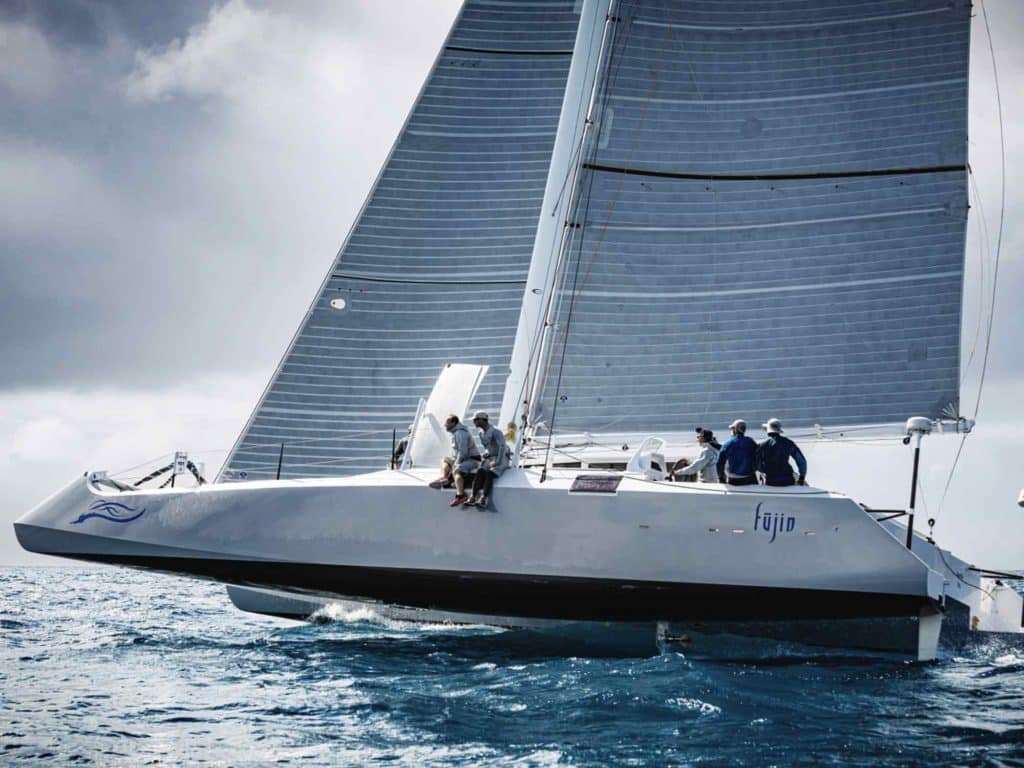
That cockpit was accessed by twin doors to either side of the wheel. When the spray was flying—which was often when screeching upwind—I actually moved from one closed door to the other open one so that I could stay dry but peek out and up for an occasional glimpse of the mainsail. When the crew tacked the sails, I tacked the doors.
But it was the pure adrenaline rush of skimming to weather at 10 knots and reaching off wind at 16-plus that provided the lasting memory. I recall at one stage glancing sideways and thinking, My goodness, that water is moving past very quickly. But it wasn’t just the speed. It was also the effortless accompanying sensation—we weren’t sailing so much as flying, lifted above the waves, somewhere in a transitory state between sea and sky.
Another thought I had that day: This type of sailing is pretty revolutionary. Looking back, it’s almost laughable. I had absolutely no clue about the changes to come.
This past fall, at the Cannes Yachting Festival in Southern France, I was standing next to Bruno Belmont, a legendary figure in the French cat scene who for many years was involved in product development at Lagoon. He recently spearheaded the team responsible for bringing Groupe Beneteau’s Excess line of cats to the market. Belmont was in the thick of things back in the 1980s, when a trio of French production-catamaran builders—Fountaine Pajot, Catana and Lagoon—basically launched the modern cat movement.
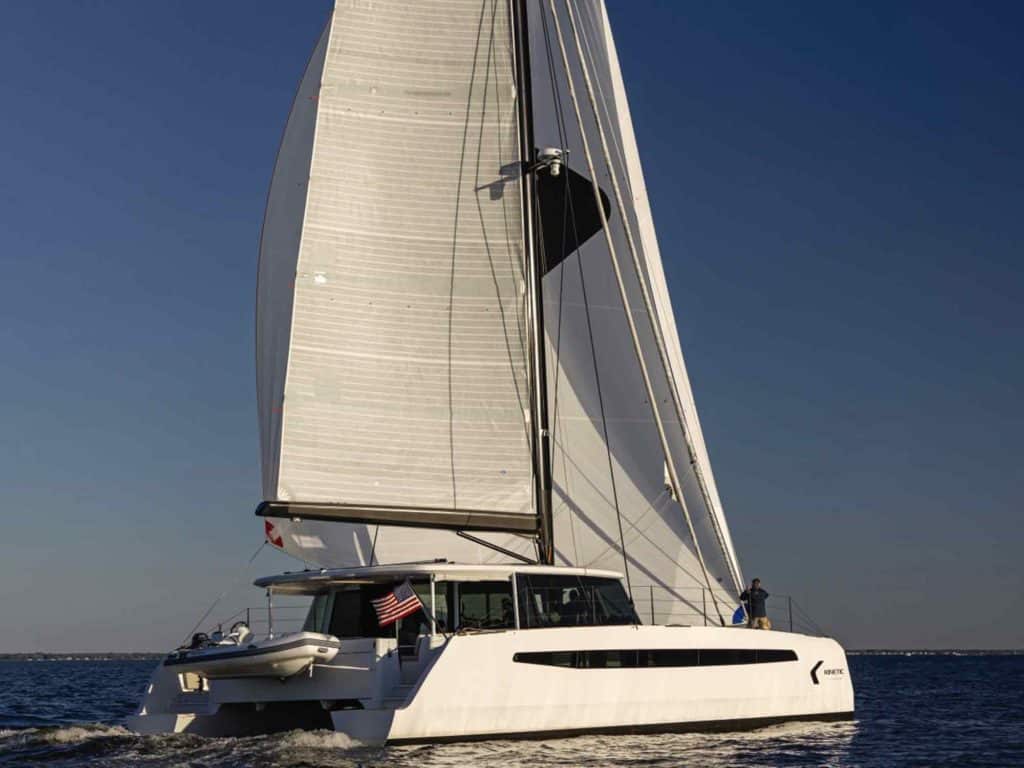
We were gazing at a new-model Lagoon, which was a towering vessel aimed at cruising and chartering with a flybridge/party deck and massive freeboard. Just then, a PowerPoint slide flashed on a nearby screen, showing one of those 1980s cats: low to the water and sleek in profile, with an understated coachroof that almost looked like an afterthought.
I asked Belmont: “How do you think things have evolved in the catamaran sector over the years?”
“That boat,” Belmont said, comparing the old with the new, “was a 60/40. Sixty percent performance, 40 percent comfort. This boat is a 40/60; the emphasis is on cruising comfort.”
The observation was elegant in its simplicity—probably even obvious—but it gave me a new perspective when evaluating all sailboats, not just catamarans. And it helped me get my mind around the power and potential of performance cats in a more recent interview with cat designer Gino Morrelli.
Morrelli and his design partner, Pete Melvin—the principals behind their eponymous Southern California naval architecture concern, Morrelli and Melvin (M&M)—have had a hand in high-profile projects such as Steve Fossett’s globe-girdling record-setter, PlayStation,and Team New Zealand’s AC72 cat for the 2013 America’s Cup. They were involved in a series of Leopard cats built in South Africa by Robertson and Caine, in the early Gunboat line, and in the HH Catamaran brand built in China.
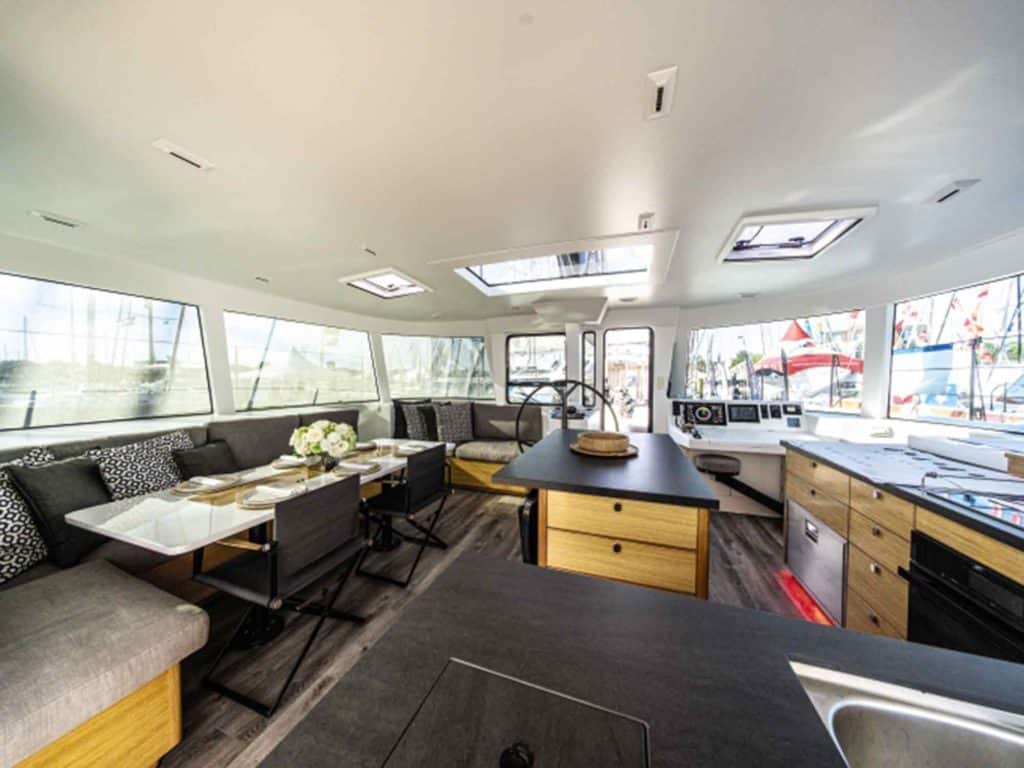
Like Belmont, Morrelli thinks in terms of percentages, but interestingly, on a quite different scale, based on windspeed.
“One of our Robertson and Caine boats, on a good day, is a 70 or 80 percent windspeed boat,” he told me. “So if it’s blowing 12 knots, they’ll sail at 9. A stock HH cat, by default, is a windspeed-plus boat, a 1.1 or a 1.2. If it’s blowing 12, you can sail 12.” He also said that Nemo, a new HH66, is a 1.5. In other words, in those pleasant 12 knots of breeze, Nemo is easily capable of trucking along at a nifty 18 knots. Whoa. How in the world did we get here?
From a broad, historical perspective, the French have played a major role, as have a long list of builders, including Robertson and Caine in South Africa, a country that fostered its own rich cat culture that continues today. And, along with M&M, a couple of other Americans were there at the forefront, including Gunboat founder Peter Johnstone and naval architect Chris White, the designer responsible for the forward cockpit (among other innovations) that’s become the defining feature of scores of performance cats. Morrelli is the first to acknowledge White’s contribution to the genre: “You know, we basically stole [that idea] from Chris and developed it to the next level.”
When I met White in the early 1980s, he was all about trimarans. He’d previously built a Jim Brown-designed Searunner 31, followed by another tri that he’d crafted himself, a 52-footer of his own design called Juniper. After a two-year cruise on her, in 1983, he opened his own design office and pivoted to twin hulls. He drew the first in a long line of his Atlantic Cat series—with the aforementioned pilothouse/forward-cockpit arrangement—that launched in 1985.
Related: 10 Affordable Cruising Catamarans
In the early 2000s, Johnstone was well-positioned to launch a brand like Gunboat. A superb racing sailor, he was a member of the famous sailing family behind J/Boats. The first pair of Gunboats were 62-footers: light, high-tech cats designed by M&M and built in South Africa of E-glass and epoxy. Johnstone commissioned one for himself, called Tribe, and took his family on a lengthy Caribbean cruise. That trip couldn’t have produced better word-of-mouth advertising. And plenty of sailors took notice.
Rallies and regattas soon followed, with cat companies learning to engage buyers through value-added benefits to their ownership. (Swan, Hylas and Oyster had been doing so for years.) Social media took that owners’ club mentality to yet another level. Once a community, always a community.
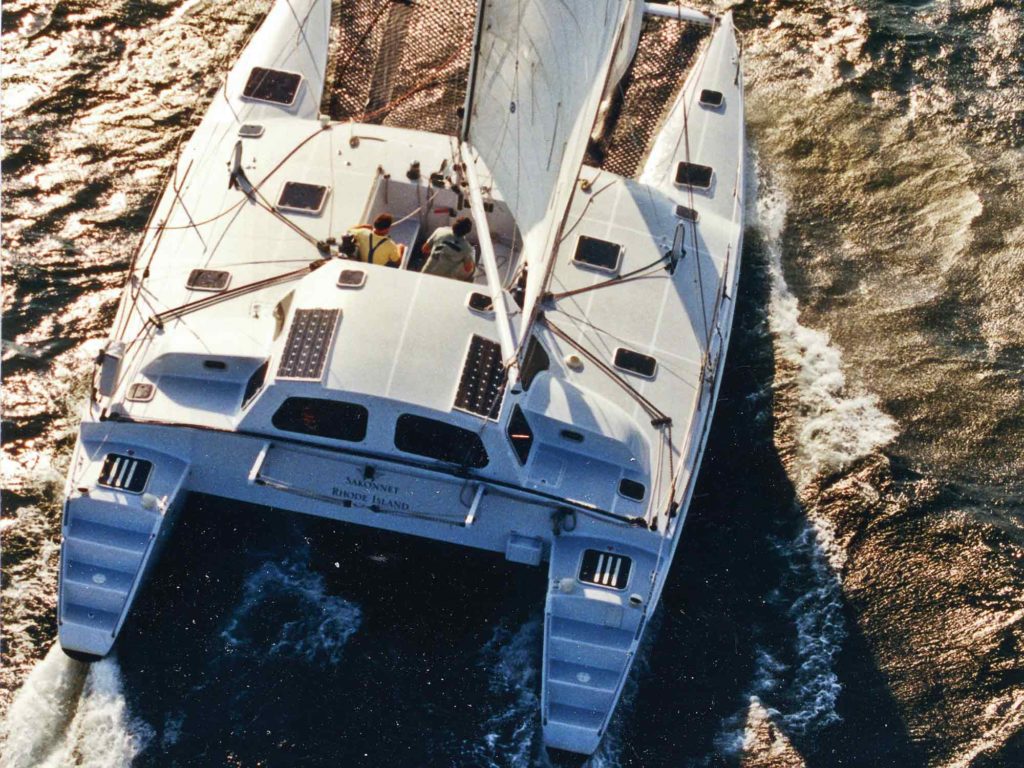
Something else has happened in recent years that Morrelli has found astounding: “It’s unbelievable to me the percentage of newbie owners we attract to HH. More than 50 percent are first-time boat owners, guys who are buying $2 million and $3 million boats. I find that a bit shocking, but they were successful at something at some point in their life, and they’re trying to roll that success and confidence into something else.”
My old Elvis imitator, Bruce Slayden—who made a killing in Las Vegas real estate—fit that description. And I met another pair this past spring while covering the Caribbean Multihull Challenge in St. Maarten.
The older brother, Greg Slyngstad, had amassed his loot in a stint at Microsoft and was sailing a custom, one-off cat called Fujin, an all-carbon 53-foot rocket designed by Pacific Northwest naval architect Paul Bieker that’s recorded speeds of over 30 knots. The boat’s striking profile—particularly the unusual bows—is reminiscent of early Polynesian cats, but Slyngstad said that aesthetics had nothing to do with it. Bieker had added volume and flotation forward to keep the bows lifted and prevent the transom from rising (and the whole show from pitchpoling) when powered up.
“That was one of the driving forces,” Slyngstad said. “The other was to cut away the shape behind the actual useful part of the bow to reduce windage. For any boat going upwind, the biggest component of drag is from the windage above the water.” By eliminating a portion of the topsides and replacing it with a sweeping curve just abaft the leading edges of the bows, Bieker created a more efficient hull form—and a quite lovely one at that.
Younger brother Todd Slyngstad—who’d earned his cash in construction in Silicon Valley—had commissioned M&M to soup up the aforementioned HH66 Nemo. One of the express purposes was to cream his sibling on the racecourse. “It was in the contract,” Morrelli said. (For the record, in the first race between the brothers, a 60-mile power reach from St. Maarten to St. Barth’s and back, Fujin nipped Nemo by less than three minutes.)
With today’s carbon cats, light (as in weight) means might (as in power), and with that objective, M&M put Nemo, as Morrelli said, “on a big diet.” The rudders and daggerboards were configured in the most efficient way possible, “and we took out what was remaining of some of the foam/glass veneers and replaced them all with carbon.”
But, he noted, there’s only so much the designers and builders can do, something I hadn’t really considered before.
“The boatbuilder gets to build only 40 percent of the displacement,” he said. “That’s the actual structure, the platform: the hulls, decks, bulkheads, interior. We purchase 60 percent of the weight: mast, engine, gensets, batteries, winches, all that stuff. Over the past five years, we’ve really worked on getting our subcontractors to lighten up their parts. That’s really low-hanging fruit.”
One very key component in that process is Gorilla Glass, originally developed by Corning for iPhones. “It’s super-tough and super-thin,” Morrelli said, “and about five years ago, it became commercially available in 5-by-10 sheets. The thickness has gone from like 12 millimeters to 8 millimeters. We’ll drop 300 kilos (more than 660 pounds) out of a boat just by reducing glass weight.”
But, Morrelli said, it was a combo platter of sails and boards that launched performance cats into the stratosphere they’ve now reached.
“The main, big difference is daggerboards,” he said. “As we started putting in these deeper boards, my joke in the office is that I blame our evolution on North Sails. As North improved their sailmaking, the reachers got better, the spinnakers got flatter, and the sails got stiffer. And as we started increasing the horsepower in the engine—the North 3Di sails—the boats went a little faster, but it wasn’t until we put bigger daggerboards on ’em that they really took off.”
Fair enough, though there is one familiar, considered voice of at least mild dissent out there on the ocean blue.
White, one of those original performance pioneers, is still at it all, and this past winter was cruising the Bahamas on his “project boat,” called Javelin, one of his Atlantic 55 models that he salvaged after a high-seas mishap and refitted at his home dock in Massachusetts during the pandemic. White says that daggerboards are only 5 percent of the picture. He adds that on a good boat going upwind, the daggerboards probably give you 5 degrees of pointing ability between tacks. What matters, to his thinking, is a combination of weight, rig, sheet leads in the right places, sails with decent shapes, balance, and reasonable hull shapes.
“You can get a nasty, sloppy boat where everything’s wrong, and pop some daggerboards in it; all it’s going to do is add more weight and slow her down,” he said in an online interview. “When you’re building and equipping these things, if you want a boat that sails well, you have to pay attention to the weight. And it adds costs to pay attention to the weight. Charter boats are all about the lowest possible cost. The weight is just whatever it comes out to.”
Efficient boards, excellent sails, light-but-robust construction: The defining elements of the modern performance-cruising cat are pretty straightforward. The trick? Combining them—with, of course, a comfortable, inviting interior layout, which is no easy feat when daggerboards must be incorporated within the hulls and saving weight is a priority.
It was a combo Platter of sails and boards that launched performance cats into the stratosphere they’ve now reached.
During the past decade, as the director of Cruising World’s Boat of the Year program, I’ve sailed every new catamaran that has debuted in the United States. American Phil Berman has found himself in the winner’s circle twice in the past five years with his line of South African-built Balance models: the Balance 526 was 2017’s Import Boat of the Year, and his latest effort, the Balance 482, was named the Best Performance Cruiser for 2022. Berman’s success with his Balance line deserves a dedicated article of its own (see “Finding Balance in High Performance” on page 48).
The M&M team has scored Boat of the Year victories with its HH series of performance cats twice: the HH55 (2018) and HH50 (2021). Longtime French builder Catana has also notched a couple of winners with its Catana 42 Carbon (2014) and Catana 53 (2019). Likewise, the Frenchmen at Outremer have scored a pair of wins: the Outremer 49 (2012) and the 60-foot Outremer 5X (2014). And Gunboat earned the Domestic Boat of the Year prize in 2015 with its Gunboat 55 Rainmaker, built in North Carolina.
For me, it all came together when I inspected and sailed another cat produced in South Africa, the Kinetic KC54. The company—founded by movie producer and real-estate developer Bob Hayward—is a serious player, with construction by Knysna-based builder Leon Scheepers and design by the Simonis Voogd naval-architecture firm, fronted by Cape Town wizard Alex Simonis.
The cost of the KC54 ($2.8 million) dissuaded our judging panel from naming it the best boat in its class, but it did receive the Judge’s Special Recognition prize, and effusive praise.
Judge Tim Murphy said: “The best-built boat in the 2022 fleet. All carbon (including the rig), Corecell foam core, all-infused epoxy resin cured in an autoclave. The whole boat felt integrated; there was no conflict in the different forces you sometimes see with accommodation versus performance. Spectacular.”
Judge Ed Sherman said: “The systems installer from Cay Electronics said he had at least 2,000 hours invested, and that’s just labor. The materials and goods are the best kit you can buy today.”
Judge Gerry Douglas summed things up: “It’s the Tesla of sailboats.”
In 10 to 12 knots of breeze during our sea trials on Chesapeake Bay, we all took a trick at the wheel. When it was my turn, as we topped 10 knots on a sweet beam reach, I was right back in the place I had discovered in Antigua at Sailing Week in 2007. I got that tingling feeling that comes when boatspeeds ascend into the double digits.
Gunboat and Kinetic: the bookends of my own personal journey with performance catamarans in the new millennium. From the design and building perspective, via the evolution that’s transpired through the people who love them, the cats are obviously quite different. But the joy and thrill of sailing them? That hasn’t changed a bit.
Herb McCormick is a CW editor-at-large.








